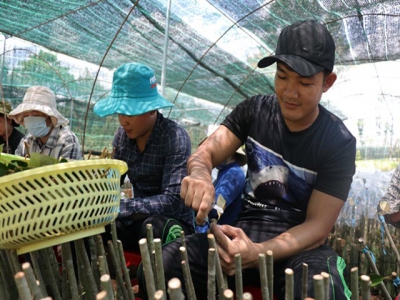Mekong Delta to have quality breed sources for fishery, fruit and rice

Ho Chi Minh City — The Ministry of Agriculture and Rural Development has implemented several measures to develop the best breeding sources to produce seeds for the delta’s fishery, fruit and rice sectors by 2025.
Grafting fruit seedlings in Bến Tre Province’s Chợ Lách District. – VNA/VNS Photo Huỳnh Phúc Hậu
The development of breeds is part of the delta's restructuring of agriculture towards sustainability and adaptation to climate change.
The delta’s key aquatic species are shrimp and tra fish which are among the delta’s top export products.
The delta produces an annual yield of 1.2 million tonnes but production of tra fry only meets 40 -50 per cent of its demand.
Last year the ministry approved a three-tier co-operation plan for production of high-quality tra fish breeds in the delta to 2025.
By 2025, tra fish breeding chains will supply 100 per cent of the delta’s demand of 2.5 – 3 billion high-quality fry a year.
The ministry will continue supporting the Research Institute for Aquaculture No. 2 to conduct research and create tra fish parents to supply to tra fry producers.
It will create favourable conditions for companies to participate in producing tra fish parents and supplying them to the delta’s tra fry producers.
The delta has about 669,000ha of brackish water shrimp, mostly black-tiger shrimp and white-legged shrimp, accounting for nearly 93 per cent of the country’s total area.
Shrimp fry producers in the delta supply about 48.3 per cent of the delta’s shrimp fry demand and the rest are bought from south-central provinces.
The difficulty in shrimp fry production is that the country has not created shrimp parents to produce fry of black-tiger shrimp and white-legged shrimp.
To manage the quality shrimp fry and parents, the ministry will tighten inspection of the import of shrimp parent breeders.
The ministry will also increase investment in research institutes and shrimp fry producing companies to produce quality fry to supply for the delta.
The delta has 335,4000ha of fruits, accounting for 36.3 per cent of the country’s total fruit area.
The fruits are mostly mango, orange, longan, durian, dragon fruit and pineapple. However, the number of original ortet trees to produce seedlings in the delta is still small and has not met the delta demand.
The ministry has assigned the Southern Horticultural Research Institute to develop breeds of the delta’s main fruits that have high yield and quality, are resistant to main pests and suitable for growing in different ecological conditions.
The ministry has targeted that the rate of certified rice seeds used for cultivation in the delta will account for up 75 per cent of the delta’s total rice seeds in 2020, 90 per cent in 2025 and 100 per cent in 2030.
Most provinces in the delta, the country’s rice granary, are replacing low quality rice varieties with new rice varieties.
Though the delta has rice varieties that are resistant to water with a low salinity rate, it does not have rice that is resistant to water with a salinity of more than 0.5 per cent and can be grown efficiently.
Related news
 1,000 tonnes of lychees ordered to process for export and comsume at supermarket
1,000 tonnes of lychees ordered to process for export and comsume at supermarket There are 3 enterprises in the northern province of Bac Giang buying the lychee for processing
 International agriculture fairs kick off in Ho Chi Minh City
International agriculture fairs kick off in Ho Chi Minh City Local business associations have organised several international agriculture fairs at Phú Thọ Stadium in District 11 from June 19 to 22.
 Sơn La exports first batch of mangoes to UK
Sơn La exports first batch of mangoes to UK The first batch of three tonnes of mangoes, grown in Yên Châu District in the northern mountainous province of Sơn La, were packaged on June 19 for export